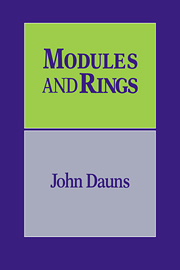Book contents
- Frontmatter
- Contents
- PREFACE
- NOTE TO THE READER
- CHAPTER 1 MODULES
- CHAPTER 2 FREE MODULES
- CHAPTER 3 INJECTIVE MODULES
- CHAPTER 4 TENSOR PRODUCTS
- CHAPTER 5 CERTAIN IMPORTANT ALGEBRAS
- CHAPTER 6 SIMPLE MODULES AND PRIMITIVE RINGS
- CHAPTER 7 THE JACOBSON RADICAL
- CHAPTER 8 SUBDIRECT PRODUCT DECOMPOSITIONS
- CHAPTER 9 PRIMES AND SEMIPRIMES
- CHAPTER 10 PROJECTIVE MODULES AND MORE ON WEDDERBURN THEOREMS
- CHAPTER 11 DIRECT SUM DECOMPOSITIONS
- CHAPTER 12 SIMPLE ALGEBRAS
- CHAPTER 13 HEREDITARY RINGS, FREE AND PROJECTIVE MODULES
- CHAPTER 14 MODULE CONSTRUCTIONS
- CHAPTER 15 CATEGORIES AND FUNCTORS
- CHAPTER 16 MODULE CATEGORIES
- CHAPTER 17 FLAT MODULES
- CHAPTER 18 PURITY
- APPENDIX A BASICS
- APPENDIX B CERTAIN IMPORTANT ALGEBRAS
- LIST OF SYMBOLS AND NOTATION
- BIBLIOGRAPHY
- SUBJECT INDEX
- AUTHOR INDEX
CHAPTER 13 - HEREDITARY RINGS, FREE AND PROJECTIVE MODULES
Published online by Cambridge University Press: 20 October 2009
- Frontmatter
- Contents
- PREFACE
- NOTE TO THE READER
- CHAPTER 1 MODULES
- CHAPTER 2 FREE MODULES
- CHAPTER 3 INJECTIVE MODULES
- CHAPTER 4 TENSOR PRODUCTS
- CHAPTER 5 CERTAIN IMPORTANT ALGEBRAS
- CHAPTER 6 SIMPLE MODULES AND PRIMITIVE RINGS
- CHAPTER 7 THE JACOBSON RADICAL
- CHAPTER 8 SUBDIRECT PRODUCT DECOMPOSITIONS
- CHAPTER 9 PRIMES AND SEMIPRIMES
- CHAPTER 10 PROJECTIVE MODULES AND MORE ON WEDDERBURN THEOREMS
- CHAPTER 11 DIRECT SUM DECOMPOSITIONS
- CHAPTER 12 SIMPLE ALGEBRAS
- CHAPTER 13 HEREDITARY RINGS, FREE AND PROJECTIVE MODULES
- CHAPTER 14 MODULE CONSTRUCTIONS
- CHAPTER 15 CATEGORIES AND FUNCTORS
- CHAPTER 16 MODULE CATEGORIES
- CHAPTER 17 FLAT MODULES
- CHAPTER 18 PURITY
- APPENDIX A BASICS
- APPENDIX B CERTAIN IMPORTANT ALGEBRAS
- LIST OF SYMBOLS AND NOTATION
- BIBLIOGRAPHY
- SUBJECT INDEX
- AUTHOR INDEX
Summary
Introduction
Thus far the following classes of rings have been studied or mentioned: prime, primitive, simple, semiprimitive (right) Artin, division ring, field, and commutative principal right ideal domain (3–2.4). The last four are special instances of hereditary rings. Finitely generated modules are discussed and then applied to semihereditary rings.
Aside from their own intrinsic interest, the semiprimitive Artin rings, and the right hereditary rings are fundamental building blocks in terms of which other rings are understood. Similarly, modules with a satisfactory structure theory, or modules which appear frequently are standard concepts needed to understand more general modules. Certainly, finitely generated modules fall in this class. Just as the word ‘Artinian’ refers ambiguously to either the right or left chain condition, so also by a hereditary ring usually is meant either a left or right hereditary one, and here the latter.
Hereditary rings
Throughout this chapter R is a ring with an identity element.
Definition. A ring R is right hereditary if 1 ∈ R and provided each of its right ideals is projective. A ring is right semihereditary if each finitely generated right ideal is projective.
The next lemma holds for any ring R.
LemmaLet C < N ⊕ B be modules with (C + N)/N projective. Then there exists a submodule A ≤ N ⊕ B such that C = (N ∩ C) ⊕ A and, A ≅ (C + N)/N.
Equivalently, if π: N ⊕ B → B is the natural projection, then C = (N ∩ C) ⊕ A where π(C) ≅ A < N ⊕ B.
- Type
- Chapter
- Information
- Modules and Rings , pp. 269 - 282Publisher: Cambridge University PressPrint publication year: 1994



